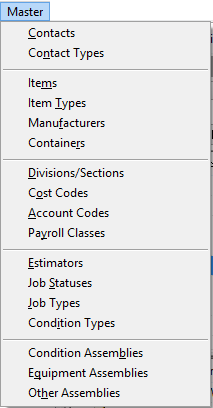
5.01.00 Master Database Tables

The Master menu provides access to all of the database tables. Master tables store the building blocks, so to speak, you will use to price Bids. Master list dialogs are labeled "Master" in the title bar to indicate database-level information - pay close attention to any modifications you make in these dialogs.
You can open a Master Table by clicking the Lookup
button ![]() next
to many fields in the program. From here, entries may be added,
modified, or deleted - this allows you to build the database "On-The-Fly"
as you are bidding. As time goes by, the database becomes more
complete - no need to completely setup all the tables before you start
bidding.
next
to many fields in the program. From here, entries may be added,
modified, or deleted - this allows you to build the database "On-The-Fly"
as you are bidding. As time goes by, the database becomes more
complete - no need to completely setup all the tables before you start
bidding.
Click Master in the menu bar to access the Master Tables.

Payroll Settings, Wage Types, and Burdens are part of a database's settings but are not included in the database's Master Tables. Learn more about modifying these settings in Chapter 7 - Setting Program Defaults and Options.
Changes made at the Master level affect all Bids in the database. There are several exceptions: changing Items, Payroll Classes, and Assemblies that have been used in a Bid already will not affect existing Bids, for example, if you modify a Master Item those changes to not affect existing uses of that Item. The first time an Item is used in a Bid, a copy of that Item is made and used throughout THAT Bid only (same for Payroll Classes. Assemblies are just templates so changing an Assembly would never update existing Bids anyway unless you RE-USE that Assembly in a Condition). You can delete Items and Payroll Classes, even if they are used in Bids, as long as they are not used in another Master record such as in a Mixture, Chain, or Assembly.
Estimators used in any Bid in the database or listed as the owner of any Assembly cannot be deleted.
Different Master Tables are inter-dependent - for example, to build an Item, you must use Payroll Classes, Labor Codes, Item Types and possibly Manufacturers so those records must be added - this can be done 'on-the-fly' as you are working in the database. Another example is before you create a Condition Assembly, you must have Items built (or build them 'on-the-fly'. It is important to review this entire section to understand the various Master Tables before attempting to use the application.
Changes made at the Master level are immediate and permanent. Proceed with caution when deleting entries from the Master menu lists - the informatoin deleted from the database CANNOT be restored (no "Undo").